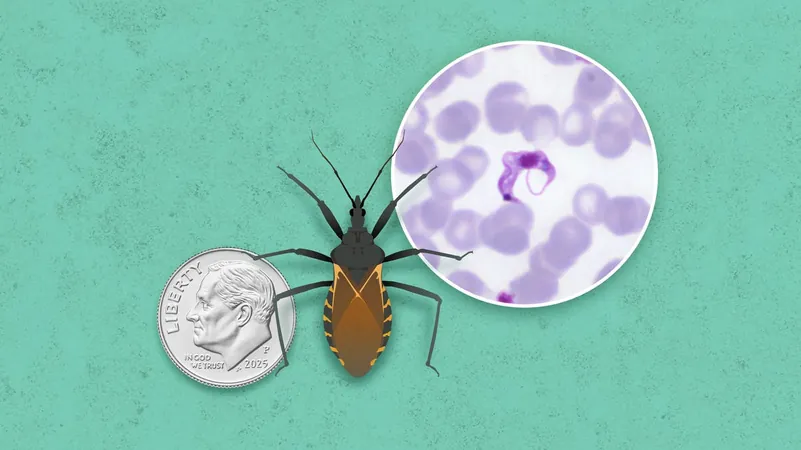
Beware the Kiss of Death: The Bloodsucking Kissing Bugs Are Spreading!
2025-09-22
Author: Ken Lee
The Dreaded Kissing Bugs: An Unwelcome Threat
Imagine a kiss that could lead you to a serious illness—this is the grim reality of the bloodsucking "kissing bugs." These creepy crawlers transmit Chagas disease, caused by the parasite Trypanosoma cruzi. Known for their tendency to bite around the mouth and eyes, these bugs are not just a nuisance; they pose a potentially fatal risk if left untreated.
An Urgent Warning from Health Officials
The Centers for Disease Control and Prevention (CDC) has raised the alarm over the rising cases of Chagas disease in the U.S., categorizing it as an endemic illness. What does this mean for Americans? The threat of Chagas disease is becoming a regular concern.
Where Are These Bugs Lurking?
Kissing bugs have been crawling around various states since the 1800s, with 11 species identified in the U.S. Alarmingly, eight states have reported local cases, including Arizona, Arkansas, California, Louisiana, Mississippi, Missouri, Tennessee, and Texas. Originally a challenge in rural areas of Latin America, where over 7 million people suffer from Chagas disease, the alarming spread into the U.S. cannot be ignored.
Spotting the Kissing Bug: What You Need to Know
These pests can be as big as a quarter, with dark brown or black bodies and distinctive stripes in shades of red, orange, or yellow. They are often found hiding in cracks and crevices of homes, particularly in rural and suburban regions, where they emerge at night to feast on the blood of humans and animals.
How Transmission Occurs
The risk escalates as kissing bugs bite infected hosts and become carriers of the parasite. They then pass the parasite through feces, which can enter the body through scratched bites or even through contact with the eyes or mouth. This transmission method makes it crucial to be vigilant!
Symptoms and Stages of Chagas Disease
Chagas disease presents itself in two phases: the acute phase, which occurs within weeks of infection, and a chronic phase that may manifest long after. Early detection is vital since the acute phase can be treated effectively with antiparasitic medications, while the chronic phase is harder to manage, offering no cure.
Recognizing the Signs of Infection
Unfortunately, many victims are oblivious to their infection as symptoms may not appear until months later. Look out for potential signs—early intervention could save lives. Testing is straightforward, involving a simple blood sample to detect the parasite.
Taking Action Against Chagas Disease
While there's currently no vaccine available, treatments do exist to help control symptoms and eliminate the parasite. Stay informed, keep your environment bug-free, and report any sightings of kissing bugs to help combat this deadly threat.

 Brasil (PT)
Brasil (PT)
 Canada (EN)
Canada (EN)
 Chile (ES)
Chile (ES)
 Česko (CS)
Česko (CS)
 대한민국 (KO)
대한민국 (KO)
 España (ES)
España (ES)
 France (FR)
France (FR)
 Hong Kong (EN)
Hong Kong (EN)
 Italia (IT)
Italia (IT)
 日本 (JA)
日本 (JA)
 Magyarország (HU)
Magyarország (HU)
 Norge (NO)
Norge (NO)
 Polska (PL)
Polska (PL)
 Schweiz (DE)
Schweiz (DE)
 Singapore (EN)
Singapore (EN)
 Sverige (SV)
Sverige (SV)
 Suomi (FI)
Suomi (FI)
 Türkiye (TR)
Türkiye (TR)
 الإمارات العربية المتحدة (AR)
الإمارات العربية المتحدة (AR)